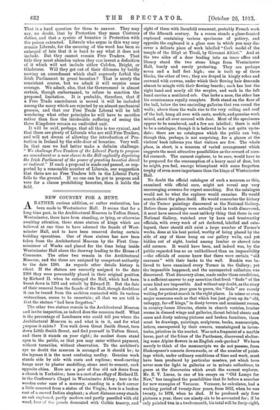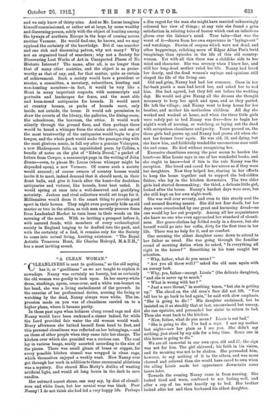NEW COUNTRY FOR A HUNT.
ARATHER curious addition, or rather restoration, has been made to Westminster Hall. It seems that for a long time past, in the Architectural Museum in Tufton Street, Westminster, there have been standing, or lying, or otherwise awaiting attention, three stone statues of kings which are believed at one time to have adorned the façade of West- minster Hall, and to have been removed during certain building operations. One of these statues has now been taken from the Architectural Museum by the First Com- missioner of Works and placed for the time being inside Westminster Hall above the doorway leading to the House of Commons. The other two remain in the Architectural Museum, and the three are assigned by competent authority to the date 1380. As regards other details history is silent. If the statues are correctly assigned to the date 1380 they were presumably placed in their original position by Richard IL when he enlarged the Hall, which had been burnt down in 1291 and rebuilt by Edward II. But the date of their removal from the façade of the Hall, though doubtless it can be traced from the archives connected with its various -estorations, seems to be uncertain ; all that we are told is that the statues " had been forgotten."
The other two statues remain in the Architectural Museum and invite inspection, as indeed does the museum itself. What is the percentage of Londoners who could tell you where the Architectural Museum is, and what is in it, and for what purpose it exists ? You walk down Great Smith Street, turn down Little Smith Street, and find yourself in Teton Street, and there it stands on your right; its modest doors stand open to the public, so that you may enter without payment, without turnstiles, without observation. To the architect's eye no doubt the museum is arranged as it should be ; to the layman it is the most confusing medley. Genuine work stands side by side with caste and replicas ; wood-carving hangs next to plaster modelling, stone next to cement, cork opposite china. Here are a pair of fine old oak doors from a church in Yorkshire ; here is a cast of an effigy of Richard II. in-the Confessor's Chapel in Westminster Abbey ; here is the wooden outer case of a mummy, standing in a dark corner a little removed from a statue of the Virgin; here is a broken cast of a carved Indian elephant ; a short distance away stands an oak cupboard, partly modern and partly panelled with old wood, four of the panels decorated with Gothic tracery, and eight of them with linenfold ornament, probably French work of the fifteenth century. In a recess stands a glass-fronted cupboard containing various specimens of pottery, and opposite the cupboard is a glass ease in which you may dis- cover a delicate piece of work labelled "Cork model of the temple of the Sibyl at Tivoli, by Giovanni Altieri." And at the two sides of a door leading into an inner office and library stand the two stone kings from Westminster Hall, lonely and surely protesting. They are perhaps seven and a half feet high ; one is built up of three blocks, the other of two ; they are draped in kingly robes and crowned with crowns, under which their flowing hair descends almost to mingle with their flowing beards ; each has lost the right hand and nearly all the sceptre, and each in the left hand carries a mutilated orb. One lacks a nose, the other has his countenance royally complete. Both stand on the floor of the hall, below the two encircling galleries that run round the walls ; above them the walls rise to the very ceiling and roof of the ball, hung all over with casts, models, and genuine work mixed, and all over covered with dust. Most of the specimens appear to be numbered, and a few are labelled ; there is said to be a catalogue, though it is believed to be not quite up-to- date ; there are no catalogues which the public can buy, though this, perhaps, is not surprising, for a glance at the visitors' book informs you that visitors are few. The whole place, in short, is a museum of varied arrangement which suggests the most attractive possibilities as the reward of care- ful research. The earnest explorer, to be sure, would have to be prepared for the consumption of a heavy meal of dust, but he might, you feel, emerge triumphant with some forgotten trophy of even more importance than the kings of Westminster Hall.
No doubt the official catalogue of such a museum as this, examined with official care, might not reveal any very encouraging avenues for expert searching. But the catalogue would not be what the explorer would examine. He would search about the place itself. He would remember the history of the Turner paintings discovered at the National Gallery. Before those paintings were actually and in truth discovered, it must have seemed the most unlikely thing that there in our National Gallery, watched over by keen and trustworthy officials, with every work of art docketed, labelled and cata- logued, there should still exist a large number of Turner's works, done at his best period, worthy of being placed by the side of any of those hung on our gallery walls, and yet hidden out of sight, buried among lumber or shoved into odd corners. It would have been, and indeed was, by the public regarded less as an unlikelihood than an impossibility —the officials of course knew that there were certain "old canvases" with their backs to the wall. Ruskin was be- lieved to have examined every Turner in the Gallery; yet the impossible happened, and the unsuspected collection was discovered. That discovery alone, made under those conditions, is a sufficient answer to any assertion that fresh " finds " of the same kind are impossible. And without any doubt, as the story of each successive year goes to prove, the " finds " are merely waiting for patient search in the right places. In minor or even major museums such as that which has just given up its " old, unhappy, far-off kings," in dusty towers and muniment rooms, in country-house libraries, chests in church vestries, lumber rooms in disused wings and galleries, thrust behind chests and cases and dusty unhung pictures and broken furniture, there must be drawings, paintings, sculptures, books, manuscripts, letters, unsuspected by their owners, uncatalogued in inven- tories, priceless in the market. Was not a fragment of a marble horse, part of the frieze of the Parthenon, discovered shelter- ing some Alpine flowers in an English rook-garden P We have merely to think of the manuscripts we do not possess, from Shakespeare's sonnets downwards, or of the number of paint- ings which, under ordinary conditions of time and work, must have been produced by particular masters, yet which have never seen the light in galleries or in private collections, to guess at the discoveries which await the earnest explorer. Mr. E. V. Lucas, in one of his essays on " Old Lamps for New," has imagined the possibilities that lie before a searcher for new examples of Vermeer. Vermeer, he calculates, had a working period of twenty-four years, from 1652, when be was twenty, to 1676, when he died. If he produced only four pictures a year, there are ninety-six to be accounted for ; if he only painted two in a twelvemonth, his total will be forty-eight, and we only know of thirty-nine. And so Mr. Lucas imagines himself commissioned, or rather set at large, by some wealthy and discerning person, solely with the object of hunting among the byways of northern Europe in the hope of coming across another Vermeer. He would find one, he knows, and we may applaud the certainty of the knowledge. But if one searcher and one rich and discerning patron, why not many P Why not an organized band of searchers ; why not a Society for Discovering Lost Works of Art in Unexpected Places of No Historic Interest? The name, after all, is no longer than that of many other societies, and the object is as praise- worthy as that of any, and, for that matter, quite as certain of achievement. Such a society would have a president or master, a committee, a secretary, subscribers, hunting and non-hunting members—in fact, it would be very like a Hunt in many important respects, with manuscripts and portraits and landscapes for foxes, and the most able and keen-nosed antiquaries for hounds. It would meet at country houses, as packs of hounds meet, only inside, not outside, the house. It would ask permission to draw the coverts of the library, the galleries, the dining-room, the schoolroom, the boxroom, the attics. It would work silently through the ground floor, and then perhaps there would be heard a whimper from the stairs above, and one of the most trustworthy of the antiquaries would begin to give tongue, and the whole pack would make the passages ring with the most glorious music, in full cry after a genuine Velasquez, a new Shakespeare folio, an unpublished poem by Collins, a bundle of notes on the plot of "Edwin Drood," a packet of letters from Cowper, a manuscript page in the writing of John .Donne—even, to please Mr. Lucas (whose whimper might be depended upon), a new Vermeer. Of course such a society would succeed ; of course owners of country houses would invite it to meet, indeed demand that it should meet, in their front halls, and give it lunch after the hunt—for doubtless antiquaries and virtuosi, like hounds, hunt best unfed. It would spring at once into a well-deserved and gratifying notoriety. Jealous and rival collectors would set traps for it. Millionaires would deem it the smart thing to provide good sport in their houses. They might even purposely hide an old master or two in the attics, as rich men secretly procure foxes from Leadenhall Market to turn loose in their woods on the morning of the meet. With so inviting a prospect before it, with assured funds, with members of every archmological society in England longing to be drafted into the pack, and with the certainty of a find, it remains only for the Society to come into actual living, hunting existence. " The Royal Artistic Treasures Hunt, Sir Charles Holroyd, M.A.T.H.," has a most inviting sound.



















































 Previous page
Previous page